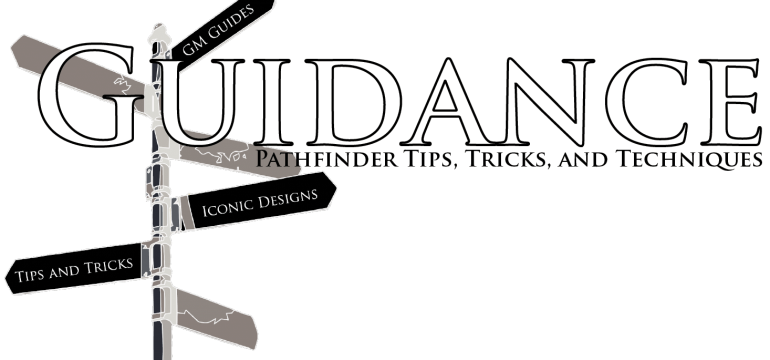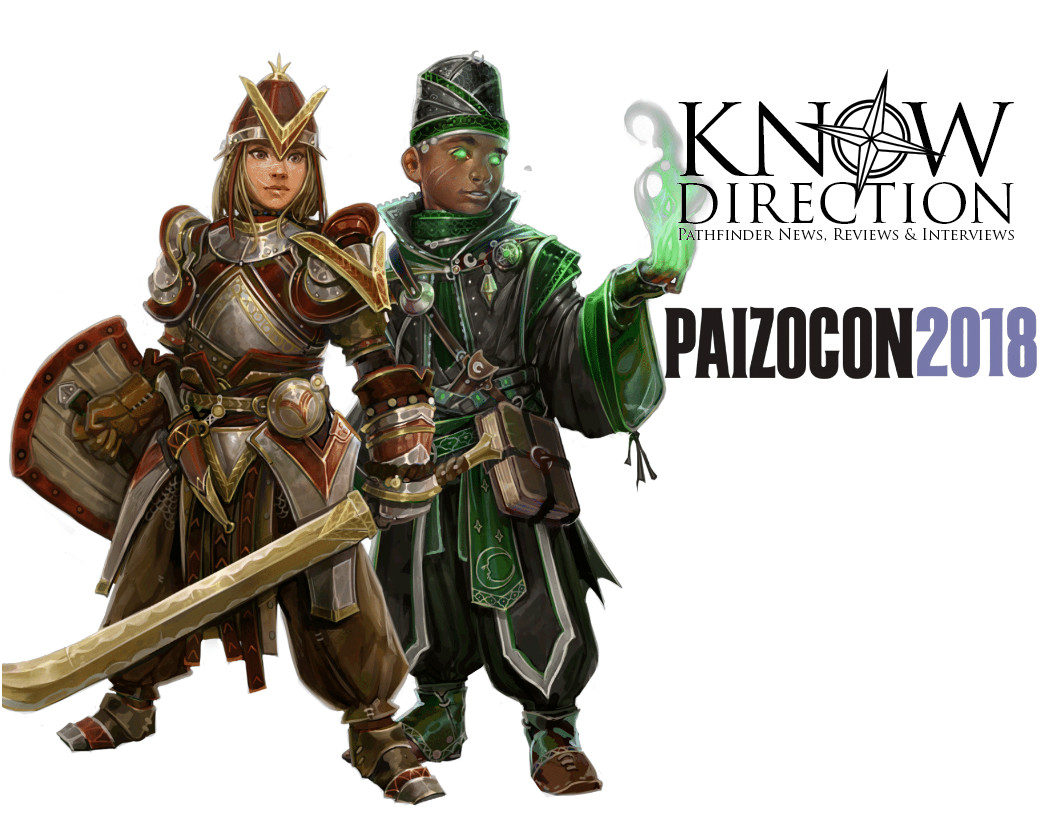Header by dziwaczka.
Welcome to Guidance! There are a lot of factors that go into presentation when you’re designing something new for an RPG, especially when you intend for your design to fill a niche that is similar to a niche that’s already been filled elsewhere. This is the kind of zone that you theoretically see things like the paladin, ranger, and fighter occupying in Pathfinder. Those three classes are VERY similar when you get right down to it—high attack bonuses, great with most armor and weapons, designed to deal damage and have a strong battlefield presence. Yet if you ask your players whether those classes feel “the same,” the answer is likely “Heck no!” The reason is that those classes are constructed with a design niche, a specific area that they perform best in. Don’t believe me? Let’s take a look.
- At 1st level, the fighter gets a bonus feat. While far from the most glamorous or even the most exciting option among our three contenders, a bonus combat feat basically says, “Do with this what you will.” As a result, we establish the fighter as our generalist class, the class that has the potential to be built in a bunch of different ways and styles. The fighter also has the ability to qualify for a staple (for better or worse) of PF feat design faster: feat chains. If a paladin, a ranger, and a fighter all want a specific feat chain, the fighter is probably going to climb it first. (There are some exceptions, of course—rangers can be faster in the specific avenue of their combat style, but the fighter holds no such limitations.)
- At 1st level, the ranger gets favored enemy. This allows them to out-hit and out-damage the fighter when combating a specific array of enemies, and to be honest that doesn’t even come from the damage bonus—its the attack bonus that makes the ranger so lethal. By 10th level, the ranger’s bonus of +6 is high enough that they basically auto-hit most at-APL enemies with their first attack, and their second attack is at a +1 advantage over a fighter’s highest-bonus attack. This is balanced by making the ranger’s bonus apply only against a specific list of enemies that they’re trained to fight, but against those enemies the ranger is VERY strong.
- At 1st level, the paladin gets smite evil, which is like a super-powered version of favored enemy against one opponent, provided the paladin invests heavily into their Charisma. Adding your Charisma to attack rolls and AC is insanely good; at 1st level its very likely that this is a +3 swing, and it will continue to rise so long as you invest into it. The paladin’s damage bonus starts out lower at 1st, but quickly soars under the right circumstances. Since this ability is so much better than favored enemy, it has a limited number of daily uses that tends to stop mattering around level 13 or so. Once you have 5 uses per day, you’re very realistically going to get a smite evil off at every opportunity.
On paper, this looks pretty good, right? The fighter gets the more general toolkit, while the ranger and paladin are progressively more limited but get more power to compensate. Well, I’m here to say that, no, this is not terribly good design for a number of reasons. Most importantly, the stress it puts on adventure designers.
Adventure Design: The Mechanic No One Remembers
This funny thing often happens to players and designers of TTRPGs—we focus on the character as it appears on paper, but not as the character plays at the table. Having a hyper-specialized character can be super awesome when you can get your awesome combo off and look super cool while everyone around you fawns at your mastery over the system, but that hyper specialization comes with a very strange downside. In other to make the game fun, the GM has to basically disrupt your cool combo / ability.
Don’t believe me? Well, let’s assume that we have a party that includes a fighter, a ranger, and a paladin. And let’s say that as GM, I’ve designed that I’m going to run a campaign like Ironfang Invasion where the PCs are assumed to fight a lot of hobgoblins, and so my ranger wisely takes favored enemy (goblin). Because of the prevalence of that favored enemy type, my adventure design choice has unwittingly made the ranger more powerful than the fighter. While I know for a fact that not every fight in Volume 1 of Ironfang Invasion consists of hobgoblins, imagine if 2/3 of the encounters did. That means roughly 60% of the time, the ranger is going to out-perform the fighter. Is that a fair expectation, for the fighter’s to shine roughly 30% less often than the ranger simply because the ranger read the Player’s Handbook?
Let’s take another step forward and talk about playing a ranger or a paladin in Wrath of the Righteous, a campaign where you’re put up against a demonic horde and their cultists. As in literally EVERYTHING you fight is evil, and most things until Book 4 or 5 are either demons or humans. Pretty much EVERYTHING. What’s worse, Book 3 mostly consists of one-a-day encounters, so about the first third of that book the paladin’s big limitation (smite evil) doesn’t really do anything. And let’s be real, with a mechanic as limited as the paladin’s smite evil, its basically just asking the paladin to horde smite evil until the big bad boss comes out, meaning the encounter with the MOST importance from a storytelling perspective is the one that the paladin is simply going to crush. As a result, the niche aspects of these classes has a negative impact on the game’s ability to tell stories because those classes are basically designed to be metagamed. (And with good reason; if you don’t metagame, those classes are worthless—imagine trying to play a paladin in Hell’s Vengeance or a ranger with favored enemy (samsaran) in Carrion Crown. Not fun.)
Shifting Gears to the Stars
This sort of niche gameplay has another problem—it typically needs to be strong enough / unique enough that a player is willing to buy into it. That’s why numerical benefits for niches like these are often a difficult sell—it is easier to see advantage in a simple bonus (like a ranger’s favored enemy bonus or a paladin’s smite evil bonus) then a cool special ability that you get to do under niche circumstances. One great example of how a well-balanced ability can end up looking and feeling awful because it lacks luster is the exocortex mechanic in Starfinder. Comparing an exocortex mechanic’s starting package to a soldier’s starting package looks a lot like this:
Soldier
- 4 + Int Skill Points per Level
- Eight class skills
- Proficiency with all armor and all weapons (except special weapons)
- Full BAB at will
- Good Fort and Will, poor Reflex
- A primary style technique that is typically as strong as two feats (see: Blitz)
Exocortex Mechanic
- 7 Stamina / 7 HP per level
- 4 + Int Skill Points per Level
- Eight class skills
- Proficiency with light armor, basic melee weapons, grenades, longarms, and small arms
- Full BAB against one foe as a move action
- Good Fort and Reflex, poor Will
- A scaling +1 bonus to Computers and Engineering checks and a free datapad.
- A free Skill Focus feat that you can reassign however you wish.
Now, if you take these two classes and compare what each has that the other does, Starfinder is essentially saying that this:
- +1 Stamina / +1 Hit Points per level (Basically, Super Toughness)
- Heavy Armor Proficiency
- Powered Armor Proficiency
- Advanced Weapon Proficiency
- Sniper Weapon Proficiency
- An ability with benefits equivalent to that of two feats
Is worth the same as this:
- The ability to boost your base attack bonus to equal that of a soldier against one foe at a time as a move action.
- A +1 bonus to Computers and Engineering checks.
- A free Skill Focus feat that can be reassigned.
- A free datapad / tool kit / engineering kit.
It really, really doesn’t look very good on paper even though its balanced. The mechanic doesn’t get more skills because Intelligence is its most important ability score, so they’re bound to have more skills then the fighter. But when you break it down as “your core combat ability simply boosts you to being at the same point as a soldier for a limited amount of time” and add that to the fact that the exocortex mechanic really isn’t that great at the skills its supposed to be the best at. For instance, if you compare any mechanic to an operative with the hacker specialization (which gives Computers and Engineering as free Skill Focuses), then that operative is going to have a bonus in both of those skills that is at least +2 higher then a mechanic with a similar Intelligence because a mechanic’s free insight bonus starts at +1, while Skill Focus’s bonus is +2.
Again, this is why trying to define niches with numbers is usually not good for the long-term health of your game. But for now, I’ve said all I care to say on this topic. What do you think? Can you think of any examples where using numerical bonuses to carve out niches worked well? For me, I think that spellcasting classes (especially cleric versus druid versus shaman) show off best how abilities like spells offer a better way of developing niches. The numbers behind both classes are exactly the same, but they feel super different because of the flavor of abilities they possess. Next week, I’m going to be making a build that messes around with some of the new Planar Adventures goodness, until then, I’m Alexander Augunas, the Everyman Gamer, and I’m always here to offer you a little bit of Guidance!







